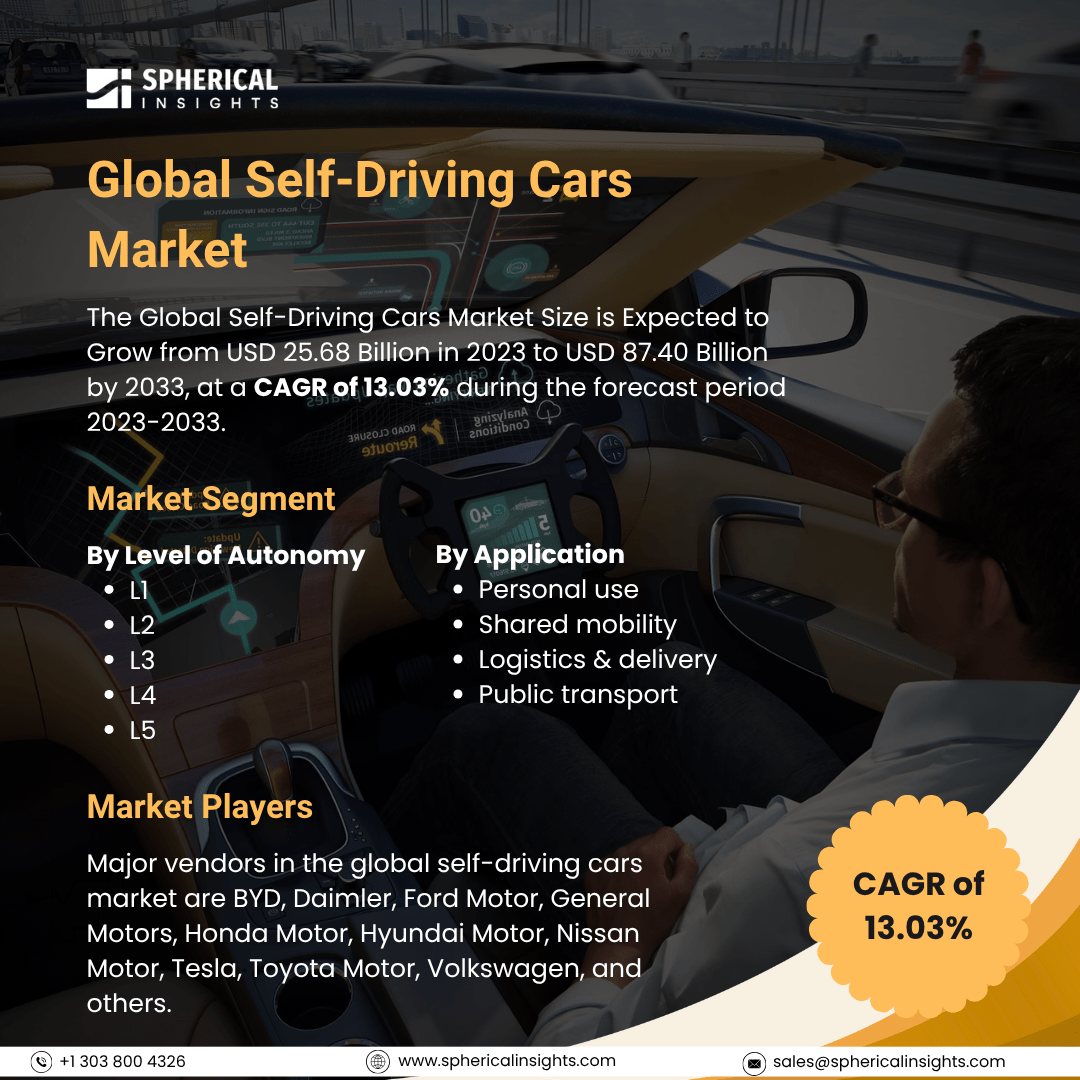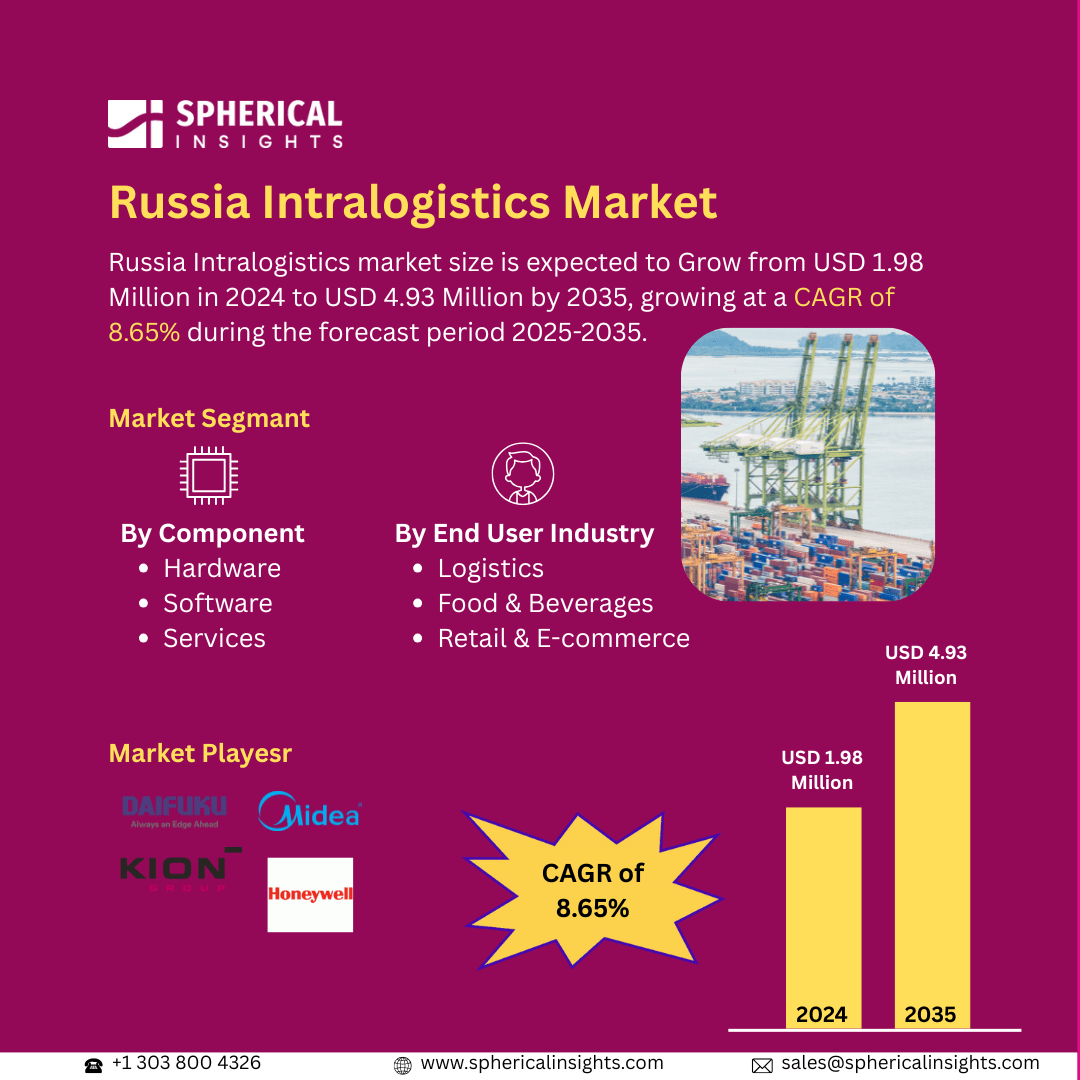Global Self-Driving Cars Market Size To Exceed USD 87.40 Billion By 2033
According to a research report published by Spherical Insights & Consulting, The Global Self-Driving Cars Market Size is Expected to Grow from USD 25.68 Billion in 2023 to USD 87.40 Billion by 2033, at a CAGR of 13.03% during the forecast period 2023-2033.
Browse 210 market data Tables and 45 Figures spread through 190 Pages and in-depth TOC on the Global Self-Driving Cars Market Size, Share, and COVID-19 Impact Analysis, By Level of Autonomy (L1, L2, L3, L4, and L5), By Application (Personal use, Shared mobility, Logistics & delivery, and Public transport), and By Region (North America, Europe, Asia-Pacific, Latin America, Middle East, and Africa), Analysis and Forecast 2023 – 2033.
The global self-driving cars market refers to the industry focused on the development, production, and commercialization of autonomous vehicles that use artificial intelligence (AI), sensors, cameras, radar, and advanced software to navigate and operate without human intervention. This market encompasses various levels of driving automation, ranging from driver assistance systems to fully autonomous vehicles, across passenger and commercial applications. Furthermore, key driving factors for the global self-driving cars market include advancements in artificial intelligence, LiDAR, and sensor technologies, growing demand for safer and more efficient transportation, and supportive government regulations. Increased investments by tech and automotive giants, along with rising interest in mobility-as-a-service (MaaS) and the potential to reduce traffic congestion and emissions, further fuel market growth. However, restraining factors in the global self-driving cars market include high development costs, regulatory uncertainties, safety concerns, ethical dilemmas in decision-making algorithms, and limited infrastructure support for autonomous vehicle deployment.
The L1 segment accounted for the largest share in 2023 and is anticipated to grow at a significant CAGR during the forecast period.
On the basis of the level of autonomy, the global self-driving cars market is divided into L1, L2, L3, L4, and L5. Among these, the L1 segment accounted for the largest share in 2023 and is anticipated to grow at a significant CAGR during the forecast period. The segmental growth is attributed to the widespread adoption of basic driver-assistance features like adaptive cruise control and lane-keeping. Its growth is fueled by regulatory encouragement, cost-effectiveness, and consumer demand for enhanced safety. Automakers continue integrating L1 systems across various vehicle categories, driving sustained market expansion during the forecast period.
The logistics & delivery segment accounted for a significant share of the global self-driving cars market in 2023 and is predicted to grow at a rapid pace over the forecast period.
On the basis of the application, the global self-driving cars market is divided into personal use, shared mobility, logistics & delivery, and public transport. Among these, the logistics & delivery segment accounted for a significant share of the global self-driving cars market in 2023 and is predicted to grow at a rapid pace over the forecast period. The segmental growth is attributed to growing demand for last-mile delivery automation, rising e-commerce activity, and cost-saving benefits. Advancements in autonomous driving technology, fuel efficiency, and 24/7 operation capabilities are driving adoption, with major players investing heavily to streamline logistics operations and enhance delivery speed.
North America is projected to hold the largest share of the global self-driving cars market over the forecast period.
North America is projected to hold the largest share of the global self-driving cars market over the forecast period. The regional growth is attributed to early technology adoption, strong presence of key autonomous vehicle developers, and supportive regulatory frameworks. High investments in R&D, a robust automotive ecosystem, and increasing demand for advanced mobility solutions further strengthen regional growth, particularly in the U.S., where pilot programs and infrastructure initiatives are accelerating deployment.
Asia Pacific is expected to grow at the fastest CAGR of the global self-driving cars market during the forecast period. The regional growth is attributed to the rapid urbanization, strong government support for smart mobility, and increasing investment in autonomous driving technology. Countries like China, Japan, and South Korea are leading with innovations, pilot programs, and partnerships aimed at reducing traffic congestion and enhancing road safety through automation.
Company Profiling
Major vendors in the global self-driving cars market are BYD, Daimler, Ford Motor, General Motors, Honda Motor, Hyundai Motor, Nissan Motor, Tesla, Toyota Motor, Volkswagen, and others.
Key Target Audience
- Market Players
- Investors
- End-users
- Government Authorities
- Consulting and Research Firm
- Venture capitalists
- Value-Added Resellers (VARs)
Recent Development
- In July 2024, Beijing declared its intention to allow self-driving cars on ride-hailing websites. To create a clear regulatory framework for autonomous vehicles, the municipal government released draft regulations and asked for public input. China's autonomous driving efforts were previously spearheaded by Beijing, which established a demonstration zone in 2020. The goal of the action was to hasten the adoption of self-driving technology in commercial transportation.
Market Segment
This study forecasts revenue at global, regional, and country levels from 2023 to 2033. Spherical Insights has segmented the global self-driving cars market based on the below-mentioned segments:
Global Self-Driving Cars Market, By Level of Autonomy
Global Self-Driving Cars Market, By Application
- Personal use
- Shared mobility
- Logistics & delivery
- Public transport
Global Self-Driving Cars Market, By Regional
- North America
- Europe
- Germany
- UK
- France
- Italy
- Spain
- Russia
- Rest of Europe
- Asia Pacific
- China
- Japan
- India
- South Korea
- Australia
- Rest of Asia Pacific
- South America
- Brazil
- Argentina
- Rest of South America
- Middle East & Africa
- UAE
- Saudi Arabia
- Qatar
- South Africa
- Rest of the Middle East & Africa



